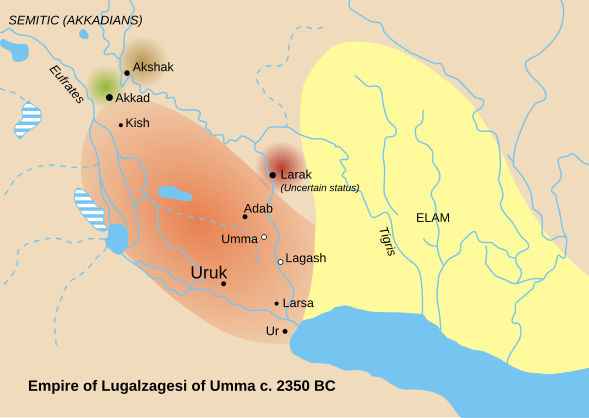7 Chapter 2.3: Art of Empire
ART OF EMPIRE
At various times in Mesopotamian history different empires controlled the region, incorporating the different city-states of ancient Sumer in them. While religion remained an important aspect, art gained a new purpose and was used to promote and glorify the ruler. Rulers especially had images made that would show their power and would strike fear into the hearts of their enemies. One of the artworks that demonstrates this to the greatest degree is the Victory Stele of Naram Sin.

Map of Sumer and surrounding kingdoms, circa 2350 B.C.E., during the reign of King Lugal-Zage-Si, the last king of Sumeria, before its conquest by Sargon of Akkad and the expansion of the Akkadian Empire (shown in green). Credit: Wikimedia user Erinthecute. CC BY-SA 4.0.
Art of Empire TASK 1: Victory Stele of Naram Sin
Rulers knew that artworks were the perfect vehicle for communicating their power. After watching the video below, please respond to the prompts.
Victory Stele of Naram Sin

Art of Empire TASK 1: Victory Stele of Naram Sin prompt:
People who erected:
Type and function of object:
Subject and historical documentation:
Symbolic elements and power:
Naram-Sin as image of power and masculinity:
Importance of landscape:
ASSYRIAN ART AND POWER
Taking a cue from the Akkadians perhaps no other Mesopotamian people exploited art as propaganda more than the Assyrians. The Assyrian kings decorated their palace extensively with art, reminding all who visited of their accomplishments and power.

Assyrian Art Gallery for UNO Students
Click this link for a gallery of Assyrian art on Artstor. This content is only available to UNO students. If you are off-campus, you will prompted to log in. For a refresher on using Artstor to find images, see the UNO Libraries Artstor Libguide.
Assyrian Art and Power TASK 1:
Based on the information provided in the sources below write a travel account of a visit to an Assyrian palace. The information in your account (requirements below) should reference the sources but does not have to recreate one specific palace. Three of the options are articles, which are listed first.
Your account should:
- Historical facts about the Assyrians (when they ruled, nature of their society and so on)
- Reference at least 3 of the sources listed (it can’t come from one source alone)
- Describe the placement of the art (where specifically was it in the palace)
- A description of the subject matter and the meaning it conveyed (should have some range – not all images are battle scenes)
- The effects of the imagery and decorations on the viewer
- Significance and content of inscriptions
- Style of art and original appearance
Article options for travel to a place:
Ashurbanipal hunting lions – Smarthistory
Please use this link for the article on the Ashurbanipal Hunting Lions.
Assyrian Art, an introduction – Khan Academy
Please use this link for the introduction to Assyrian Art article.
Assyrian Sculpture – Khan Academy
Please use this link for the Assyrian sculpture article from Khan Academy.
Options for your travel account to a palace:
Explore the Palace of King Ashurnasirpal II – Hood Museum
Assyria: Power and Propaganda – Getty Museum
The Palace decoration of Ashurbanipal – The British Museum
The Assyrian Lion Hunt Reliefs – Masterpieces of the British Museum (1/2)
Lamassu from the citadel of Sargon II – Smarthistory
How the dizzying repetition of these Assyrian reliefs gives they hyperreality| Art, Explained – The Met
Designed to Impress and Overwhelm | A 3,000-year-old Assyrian Relief – Christie’s

